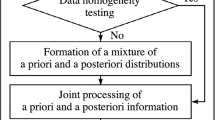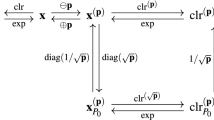Abstract
The article examines the moment and compositional approaches to solving the measurement problem of calibration. The use of the moment approach in solving a standard example problem of thermometer calibration is considered. In this work, this problem is solved under the compositional approach, yielding more accurate and better results as compared to the moment approach. This fact is consistent with the accuracy assessment of solutions to measurement problems performed back in 2001 using the compositional approach (more rigorous than the moment approach): in the problem of measuring instrument calibration, the moment approach fails to fully take into account the inadequacy of functional models, overestimates the accuracy, and fails to obtain nonlinear models of optimal complexity. In order to solve the measurement problem under the compositional approach, the present work used the MMI-calibration 3.0 program, which provides a means to factor in the inadequacy errors of mathematical models of calibration functions and to obtain tolerance intervals for a given confidence level. Among polynomials up to and including degree nine, a three-parameter model of optimal complexity was obtained, with an average modulus of inadequacy error of 0.002745℃ and a tolerance interval of [−0.00828; 0.00761] at a confidence level of 0.95. Under the compositional approach, the average modulus of inadequacy error and kappa test used to find the optimal complexity model were compared. The compositional approach is shown to be rigorous in describing the solution of the calibration problem without simplifications and to avoid overestimation of accuracy; therefore, it can serve as an exemplary approach provided the MMI-calibration 3.0 program is applied. The combined use of the criteria of minimum average modulus of inadequacy error and maximum kappa test constitutes a necessary and sufficient condition for identifying a model of optimal complexity in the class of polynomials of degree n.
Similar content being viewed by others
Notes
GUIDE 98‑3. Uncertainty of Measurement—Part 3: Guide to the Expression of Uncertainty in Measurement (GUM 1995).
GOST 8.009-84. GSI. Standardized Metrological Characteristics of Measuring Instruments.
MI 2090-91. GSI. Measurement of Physical Quantities. General Requirements.
GOST 8.207-76. GSI. Direct Measurements with Multiple Observations. Methods of Processing the Results of Observations. Basic Principles.
MI 1967-89. GSI. Selection of Measurement Methods and Measuring Instruments in the Development of Measurement Procedures. General Provisions.
MI 2083-90. GSI. Indirect Measurements. Determination of Measurement Results and Their Errors.
R 50.2.004-2000. GSI. Determination of Characteristics Defining the Mathematical Models of Dependences between Physical Quantities in the Solution of Measurement Problems. Basic Provisions.
MI 2916-2005. GSI. Identification of Probability Distributions in the Solution of Measurement Problems.
Guide for Applicants and Accredited Persons to Formalizing the Scope of Accreditation of Calibration Laboratories Taking Uncertainty into Account, available at: https://fsa.gov.ru/documents/6769/ (accessed: 11/09/2023).
ISO/IEC Guide 98-3:2008. Uncertainty of Measurement—Part 3: Guide to the Expression of Uncertainty in Measurement (GUM:1995).
R 50.1.109-2016. ILAC Policy for Uncertainty in Calibration.
References
Guide to the Expression of Uncertainty in Measurement [Russian translation], ed. by Prof. V. A. Slaev, D. I. Mendeleev VNIIM, St. Petersburg (1999).
International Dictionary of Metrology: Basic and General Concepts and Corresponding Terms [in Russian, 2nd edn. D. I. Mendeleev VNIIM, BelGIM, Professional Publ, St. Petersburg (2010)
Levin, S.F.: Metrologiya. Matematicheskaya statistika. Legendy i mify 20-go veka: Legenda o neopredelyonnosti. Partn. Konkur. (1), 13–25 (2001)
Levin, S.F.: Meas. Tech. 61(2), 91–97 (2018). https://doi.org/10.1007/s11018-018-1393-6
Levin, S.F.: Meas. Tech. 61(4), 327–334 (2018). https://doi.org/10.1007/s11018-018-1429-y
Levin, S.F.: Guide to the expression of measurement uncertainty: problems, unrealized opportunities and revision. Part 3. Reduction to a common terminological denominator. Izmer. Tekhn. (2019). https://doi.org/10.32446/0368-1025it.2019-7-14-22
Jacobi, C.G.J.: De Determinantibus functionalibus. J. Math. 22, 319–359 (1841)
Chikmarev, A.D.: Meas. Tech. 63(9), 686–689 (2020). https://doi.org/10.1007/s11018-021-01840-5
Levin, S.F.: Meas. Tech. 63(7), 524–533 (2020). https://doi.org/10.1007/s11018-020-01819-8
Chikmarev, A.D.: Meas. Tech. 65(8), 584–589 (2022). https://doi.org/10.1007/s11018-023-02124-w
Author information
Authors and Affiliations
Corresponding author
Ethics declarations
Conflict of interest
The author declares no conflict of interest.
Additional information
Translated from Izmeritel’naya Tekhnika, No. 11, pp. 33–37, November 2023. Russian DOI: https://doi.org/10.32446/0368-1025it.2023-11-33-37
Publisher’s Note
Springer Nature remains neutral with regard to jurisdictional claims in published maps and institutional affiliations.
Original article submitted 06/19/2023. Accepted 10/18/2023
Rights and permissions
Springer Nature or its licensor (e.g. a society or other partner) holds exclusive rights to this article under a publishing agreement with the author(s) or other rightsholder(s); author self-archiving of the accepted manuscript version of this article is solely governed by the terms of such publishing agreement and applicable law.
About this article
Cite this article
Chikmarev, A.D. Analysis of compositional and moment approaches to solving the calibration problem using a standard example. Meas Tech (2024). https://doi.org/10.1007/s11018-024-02299-w
Published:
DOI: https://doi.org/10.1007/s11018-024-02299-w
Keywords
- Measuring instruments
- Calibration
- Accuracy assessment
- Moment approach
- Measurement uncertainty
- Compositional approach
- Inadequacy error
- Convolution
- Practice




